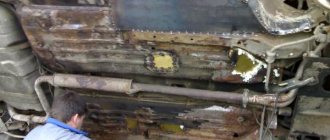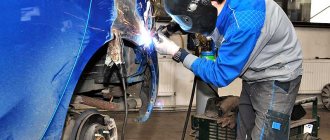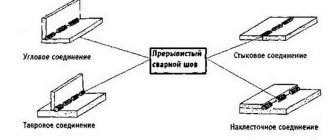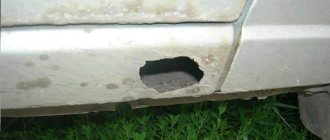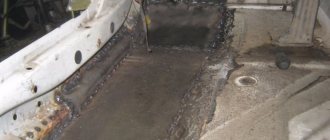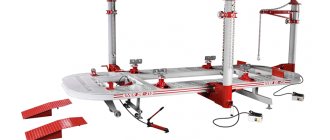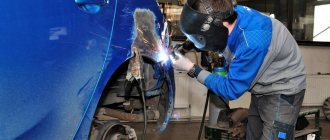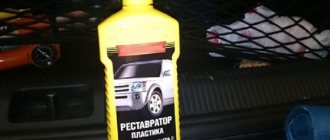Repairing the underbody of a car is not a frequent task, but it is one of the most difficult types of body work that requires qualifications and experience. The bottom, sills, and wheel arches are subject to the greatest destruction from corrosion and mechanical damage.
Operating a car on bad roads, flying gravel, winter use of salt reagents on the streets, incorrect or minimal application of anti-gravel and anti-corrosion protection are the first reasons for the rapid destruction of metal. 70% of drivers are faced with the need to digest sills, change or repair the underbody 5-7 years after purchasing a new car.
Repair tools and materials
In half of the cases, the need for a full underbody repair is discovered by technicians at a service station during routine vehicle diagnostics. When the car is lifted onto an overpass, it is easier for a mechanic to see corrosion plaques on the metal, dents from impacts, etc. The cost of repairs depends on the degree of damage; in a workshop this is a justifiably high price of 10,000 rubles. only for overcooking the thresholds.
But in the case of a body, the degree of damage to the metal may be excessive and it will not be necessary to repair the bottom with patches, but to completely or partially replace the load-bearing elements. Many drivers choose garage repairs; it is 10-15 times cheaper; if the technician has skills in gas or electric welding, the cost of the work is minimal.
Before welding the underbody of a car with your own hands, you need to prepare the following tools and materials:
- calcium carbide, oxygen cylinder if gas welding is used;
- copper wire, carbon dioxide, if welding is performed semi-automatically;
- metal for patches;
- replacement wheels for a grinding machine;
- bitumen mastic, paraffin anticorrosive for treating the external and internal surface of the bottom;
- putty.
Equipment and tools that will be required for repairs:
- grinder (angle grinder);
- chisel with a wide blade;
- welding machine;
- metal scissors;
- straightening hammers;
- electric drill.
During the work, you may need a degreaser, a spot welding machine for tack, and R-80 sandpaper.
What is needed to repair the bottom?
As the saying goes: “If you want something done well, do it yourself.” Car underbody repair is no exception. To implement this you will need the following equipment:
- Semi-automatic welding machine.
- Gas welding.
- Regular metal scissors or electric.
- Grinder (angle grinder).
- Hammers of various sizes and configurations.
- Good lighting.
You also need to stock up on the following materials:
- Oxygen and calcium carbide (for gas welding).
- Carbon dioxide and copper wire (for a semi-automatic welding machine).
- Wheels for cutting and grinding metal on a grinder.
- Metal for patches.
What metal to use to weld the underbody of a car, its thickness
The thickness of the metal for over-welding the floor must be at least 2 mm. Technologists recommend using sheet steel, material st2, to save money. Stainless steel or alloy steel can be used if the repair is done by a professional welder. In 70% of cases, non-professionals experience welding joints bursting due to engine vibration when moving.
Stainless steel can be used as small patches for partial bottom replacements. Aluminum sheets are used to strengthen the bottom of the car without welding. Aluminum oxidizes the metal, causing rapid corrosion. If aluminum is used to strengthen the bottom, it is necessary to avoid its contact with the metal of the body through the use of rubber bushings or gaskets.
Steel body
A steel body can be of different alloy variations, which gives completely different properties to its varieties. So, for example, sheet steel has excellent ductility, which also makes it possible to produce outer panels of body parts, which can sometimes have a rather unusual and complex shape. It is logical that high-strength grades have considerable energy intensity and excellent strength, which is why this type of steel is used in the production of power body parts. It is also beneficial that throughout the history of the automotive industry, manufacturers have managed to simplify and fine-tune the craftsmanship of steel bodies, which makes them quite inexpensive.
It is this factor that has made steel bodies the most popular in the automotive market today.
With all these advantages, steel still has significant disadvantages. For example, it is inconvenient that steel parts are not light in weight and are also susceptible to corrosion processes, which forces manufacturers to use galvanizing techniques for steel parts and at the same time look for alternative options for body materials.
Stages of work
Only in the video tutorial does it take a short period of time to independently overcook the bottom. In fact, repair work takes from 3 days and goes through the following stages:
- dismantling the interior, interior lining;
- bottom preparation;
- welding work;
- anti-corrosion treatment;
- interior installation, electrical connections.
Dismantling the interior involves disconnecting most of the electrical cables that go to power windows, batteries, sensors, also removing seats, carpet, sound insulation, dismantling doors, installing the car on an overpass or lift. Be sure to drain the fuel from the tank.
Some drivers turn the car on its side if the bottom and sills are partially overcooked.
After dismantling the attachments and panels, it is necessary to check the quality of the metal on the sills and wheel arches. These elements are the first to be damaged by corrosion.
Preparatory work
Before the main stage of repair, it is necessary to prepare the bottom. Algorithm of work step by step:
- Use a grinder to clean the outer part of dirt and rust.
- Check the jacks.
- After cutting away the rusty areas of metal, sand the outside of the bottom to white metal.
- Cut patches to the required size if a partial replacement is being carried out. Drill out the spot welding areas if the entire bottom is being replaced or cut out the factory fastening weld.
It is recommended to cut steel for patches using metal scissors. The workpiece will have an even seam. Cutting a patch by welding is carried out if you have experience, such work requires skill.
Replacement of car underbody elements
The first problems with the body begin with the failure of the same elements, regardless of the manufacturer and operating conditions. Comprehensive bottom re-cooking begins with inspection and repair of those parts that are more susceptible to corrosion due to constant contact with moisture:
- thresholds;
- wheel arches;
- front bumper;
- trunk bottom.
Operating principle and theory of semi-automatic electric welding
Welding with a semi-automatic inverter using carbon dioxide is today the most common type for self-repair of the bottom. Using gas welding is quite problematic, since it is difficult to make a high-quality seam.
The carbon dioxide semi-automatic machine allows you to weld metal with a thickness of 0.8 to 6 mm, has compact dimensions, and is convenient for welding difficult areas. The machine uses carbon dioxide; it enters the welding zone under pressure and displaces air, preventing oxidation of the metal, which does not burn, but melts. The welded sections are connected, forming an even, narrow seam.
Preparation of the welding machine takes place in the following stages:
- Check the garage electrical system for the required voltage.
- Remove all flammable materials from the vehicle and within a radius of 1 meter from the work site, remove the battery, and drain the fuel.
- Insert welding wire into the inverter.
- Set the required polarity for ordinary wire used for welding metal. The minus is placed on the clamp and the plus on the burner.
- Connect the carbon dioxide cylinder.
- Check the inverter for functionality. First, the gas is supplied, then the wire is turned on and the welding current is supplied.
It is recommended to use technical carbon dioxide for welding; the chemical has less water vapor than food-grade carbon dioxide.
What seam to weld the underbody of a car
There are several techniques for cooking the bottom of a car. Professional tinsmiths recommend using step welding, welding in stitches: 2 cm of welded metal, 5 cm gap. This type of welding increases the rigidity of the body and enhances the tensile safety of the structure. During vibration during movement, the bottom does not deform, as with welding with a continuous seam, and does not tear, as with spot welding.
If the front floor elements of a car are attached to a cross beam, the attachment points must be welded.
After welding, galvanized body parts lose their protection; treatment with anti-corrosion compounds and painting with body sealant is mandatory.
If you need to weld car sills, then electric welding is used. If it is necessary to extract metal after a dent or weld a small patch, spot welding is used with a spotter.
Semi-automatic welding of car underbody
I consider this method to be the best because the work is easier and completed faster. For welding the bottom of a car with a semi-automatic machine, I recommend the following models:.
- PTK MASTER MIG 180 F15 is a simple and reliable budget semi-automatic machine for the garage. If you want to cook the car yourself, this is a great choice.
- Svarog REAL MIG 200 (N24002N) is also a simple device, but at 200 A (can be useful for welding thicker metal, such as gates, wicket hinges).
- AuroraPRO OVERMAN 200 is another budget device for repairing the bottom by welding, but it is capable of working when the incoming voltage drops up to 140 V. This is relevant if your garage has such problems with electricity.
- Fubag INMIG 200 SYN Plus is a semi-professional machine, which should be considered by car service technicians and craftsmen. Fine settings will ensure comfort when working with bottom metal.
- KEMPPI MinarcMIG EVO 170 is a reliable and durable semi-automatic machine with a graphic display. With a current of 100 A, you can cook continuously, which is important for long-term work in a car service station.
- I recommend that the welding wire for repairing the underbody of a car be copper-plated. Then the seam will better resist the constant vibrations present on the body. Buy, for example, ESAB OK Autrod 12.51 wire with a diameter of 0.8 mm.
The final stages when working with the bottom
After welding the car body with a semi-automatic machine, you will need to clean the seams with a grinder, treat them with anticorrosive, and prime them. After welding, the main vulnerable spots remain the weld seams, since the process of digesting the metal has damaged its structure. It is necessary to process the seam both from the outside of the bottom and from the inside.
If an aluminum patch is welded to a metal body, then it is necessary to apply anticorrosive in two layers and regularly check and tap the seam. Aluminum oxidizes and upon contact with sheet metal, pockets of corrosion form on steel sheets. Craftsmen do not recommend welding aluminum to the tin bottom of the machine; it is better to use bolt mounting with a safety gasket.
Welding process
It is advisable to use two people to weld the bottom. It will be difficult for one person to fix the patch and scald it at the same time. If the metal is applied to a flat surface, then it is faster to fix it using a semi-automatic welding machine.
If it is necessary to make a bend, you should resort to gas welding. When heated, the metal becomes soft and can be bent and given the desired configuration using a hammer. It should not be forgotten that high temperature reduces the properties of the metal. Another option in this case could be a special device designed to create bends on metal workpieces.
After completing the welding work, all seams must be cleaned with a grinder and coated with anti-corrosion compounds.
How to save money
The only way to save on auto body work is to do it yourself. You cannot skimp on either anti-corrosion treatment material or metal. If you are not an experienced welder and doubt the quality of the repair, it will be cheaper to invite a specialist than to redo broken seams a year later.
The cost of underbody repair in a specialized car service starts from 22-25,000 rubles. And this price is justified. Included in the price:
- interior dismantling;
- full body diagnostics;
- use of spot and electric welding;
- bottom treatment with anticorrosive agent;
- interior installation, electrical equipment connection.
Drivers prefer to do their own repairs because the stereotype is that service stations increase prices and invent defects that do not exist. To avoid deception, it is recommended to tap the bottom of the car yourself on an overpass; if there is minor damage that does not require complete overcooking of the bottom, then opt for independent repairs.
Cold methods of sealing holes in metal
Cold methods of auto body repair include:
- Metal extraction. If there is a dent on the threshold, fender without breaking the part. Use a reverse hammer or pulling hooks. Spot welding is required for repairs.
- Applying metal patches. The method is suitable for repairing the bottom, sills, and less often wings. The patch is installed in place of a rupture or hole after corrosion by welding, less often on bolts with reinforcements.
- Restoration by alternative methods using epoxy resin and fiberglass. This method is not suitable for repairing the bottom because it does not solve the main problem. If a corrosion hole appears, the body begins to deform and all power units are displaced. What is required is not just filling the hole, but restoring the rigidity of the structure, welding the bottom with the obligatory strengthening of the jacks and side members. It is allowed to install patches on rivets only in those areas of the body that do not bear a force load.
Repair of large-scale damage
Large-scale damage to the body after an accident always means overcooking of parts. For dents of a large area, when the hinged element is damaged, but the sill protection, side members, central and A-pillar reinforcements are not damaged, use back hammer extraction or straightening.
A source of through corrosion, or simply a hole, in the bottom of the car is the price to pay for comfort in the cabin. Its primary source is not anti-icing reagents acting outside, but moisture accumulating under the “pie” of heat, sound and waterproofing. Therefore, when eliminating it, work is carried out mainly from the inside.
If you follow all safety rules when welding, you must completely dismantle the interior, including the trim. This is always very time consuming. Therefore, the question of how to seal the bottom of a car without welding is very relevant. Moreover, most alternative methods do not give worse, but rather better results.
Cold methods of sealing holes in metal
There are two ways to repair holes in the underbody of a car without using hot work.
- Using composite materials - various types of polymer resins in combination with a reinforcing filler and a curing reaction accelerator. With high-quality surface treatment, in addition to restoring mechanical strength, they play the role of inhibitors - retarders of chemical and electrochemical corrosion reactions;
- Installing sheet material patches onto rivets.
General technological rules
Holes in the bottom are usually discovered from the outside, when inspecting the car on a pit or lift. Signs of through corrosion are local swellings, which, when you try to pick them out, crumble into dust.
If you find such troubles, you need to open and remove the pie of heat, noise and waterproofing on the floor in the cabin in the entire area where the sheet of iron forming the floor is welded to the power elements of the body - thresholds, tunnel and others. Then you will see the whole picture of the damage and will be able to take preventive measures in those places where corrosion has not yet become through.
Composite body
Another type of body material is composite materials. It is a “hybrid” material made from several combined together. Such production makes the composite body optimal in quality, since it combines the best from each component.
In addition, composite materials are more durable, they can be used to make the largest and most continuous parts, which undoubtedly simplifies the production itself.
Composite materials include, for example, carbon fiber, which, by the way, is most often used in production. Carbon fiber is used to make body frames for supercars.
The disadvantages of this material include the complexity of its use in the automotive industry. Sometimes manual labor is even necessary, which, of course, ultimately affects the price. Another drawback is the almost impossibility of restoring carbon fiber parts after deformation during accidents. All this contributes to the fact that cars with carbon fiber bodies are practically not produced en masse.
Each body type has its own advantages and disadvantages. It all depends on the tastes of consumers, that is, you and me.
Is it worth soldering
You can also seal holes in the bottom using soldering. However, ordinary household soldering irons are not suitable for heating metal with a thickness of 0.5 mm or more. Most likely, a hair dryer will not help you with this. You need to use a portable gas burner, for example, Super-Ego R355, which fits into a small - volume from 400 to 700 ml - cylinder for camping stoves.
Solder and flux are required for soldering. The solder used is low-melting, with a predominant content of tin or lead. Flux can be replaced with electrolytic acid. The connection is strong and can withstand high vibration loads.
Soldering has two disadvantages.
- It involves hot work, which increases the overall complexity of the repair. This can be neglected if your hands grow from the right place;
- The main material of solder - lead or tin - is a substance that has a lower electronegative potential than iron. Therefore, upon their contact, electrochemical corrosion occurs, in which iron will play the role of a “sacrificial anode” and be destroyed.
Now you have an idea of how to seal the underbody of a car without welding. If you are careful and persistent in cleaning the surfaces, then treating them and protecting them, then the installed patch can outlive the car itself.

